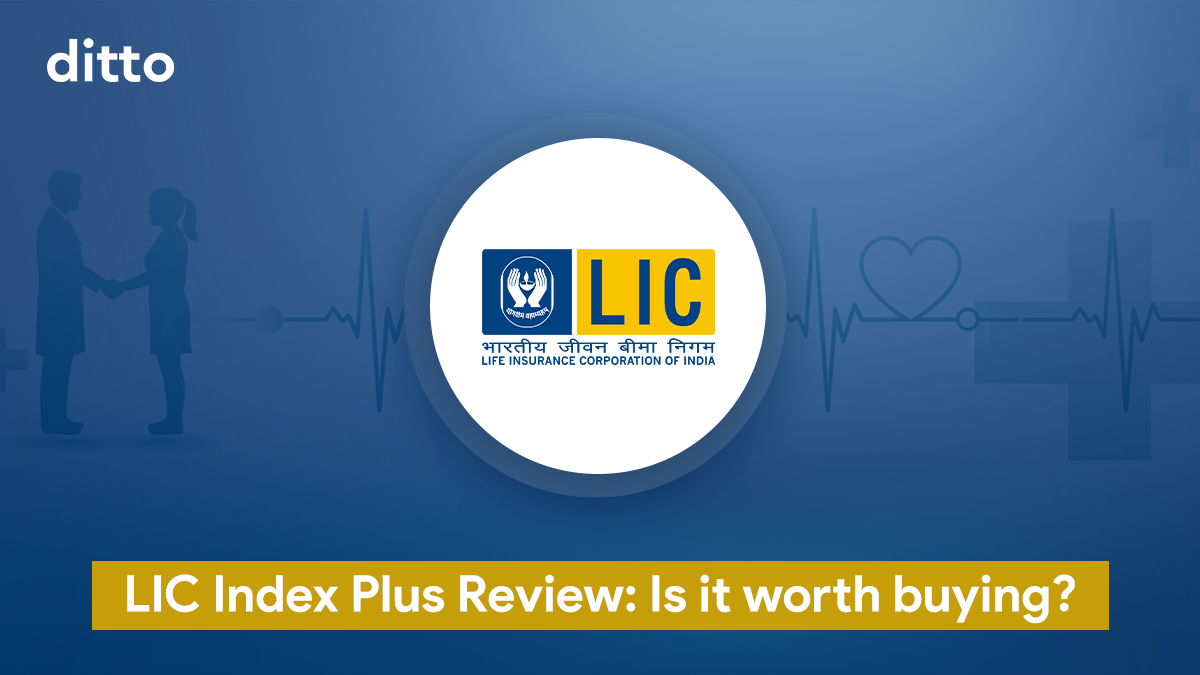LIC’s Index Plus is marketed as a ULIP that lets you grow with the market while providing life cover. The plan highlights its low entry point (₹2,500/month), guaranteed additions to your fund from year 6, and simple investment options tied to the Nifty 50 and Nifty 100 indices. The approach is straightforward: market growth plus LIC’s brand trust, wrapped into one plan.
But like most ULIPs, the marketing emphasizes benefits without fully unpacking the costs, restrictions, and trade-offs. Life cover, guaranteed additions, and “low charges” sound appealing until you run the numbers.
The real question with a ULIP isn’t about its marketing, but whether it manages to create worthwhile value after all charges, restrictions, and lock-in periods. We’ll dig into that in this review.
Still unsure if LIC Index Plus is right for you? Talk to a Ditto expert today and get personalized advice tailored to your goals.
What is LIC Index Plus?
LIC Index Plus is a Unit Linked Insurance Plan (ULIP) from LIC. It combines stock market–linked growth with a basic life cover. You pay premiums regularly: monthly, quarterly, half-yearly, or yearly, and LIC invests the money into one of two funds that focus on companies from the NIFTY 50 or NIFTY 100.
Its headlining features include:
- Market-Linked Growth: Your money goes into LIC funds that mainly invest in NIFTY 50 or NIFTY 100 companies. So, your returns depend on how these stocks perform.
- Life Cover: If you’re 50 or younger, you can choose a cover of 7× or 10× your yearly premium. For ages 51–60, it’s fixed at 7×.
- Guaranteed Additions: At the end of years 6, 10, 15, 20, and 25, LIC adds extra units to your fund. If your yearly premium is ₹48,000 or more, these top-ups range from 5% to 30% of your premium. If it’s less, the range is 3% to 18%.
- Partial Withdrawals: After the 5-year lock-in, you can withdraw a portion of your fund. Limits apply, starting at 20% in the early years and going up to 35% later.
- Refund of Mortality Charges: If you pay all premiums and stay invested till maturity, LIC refunds the life cover charges it deducted over the years, adding a little extra to your maturity payout.
Put simply, LIC Index Plus suits long-term investors who want to benefit from the stock market, with the added comfort of guaranteed bonuses and the reliability of LIC.
LIC Index Plus: Combining Market Growth with Life Cover
In LIC Index Plus, the maturity proceeds are nothing more than the fund value, essentially whatever your investment has grown to after deducting charges. The death benefit, meanwhile, is the highest of these three:
- The Sum Assured (7× or 10× your annual premium, depending on your entry age)
- The current Fund Value
- 105% of the total premiums paid
This appears like meaningful insurance protection, but in reality, the life cover component is modest at best. That’s because IRDAI mandates a minimum cover of 7× or 10× the premium, and LIC provides just that, without going any higher.
For instance, if your annual premium is ₹1 lakh, the cover amounts to only ₹7 lakh. Should death occur early in the policy, that’s all the nominee would receive. By comparison, putting the same ₹1 lakh into a pure term plan could purchase a cover of ₹1 crore or more, with spare money left to invest separately.
The brochure also reveals some fine print worth noting:
- Partial withdrawals reduce death cover if death occurs within two years after withdrawal.
- Mortality charges are refunded only on policy maturity. Exit sooner, and these disappear.
- Early years' fund values are low after charges, so nominee payouts may just meet minimum cover.
- Cover ends when the policy matures and the fund pays out.
| Ditto’s Take: ULIPs primarily serve as market-linked investment plans with limited insurance coverage. For comprehensive protection, term insurance is recommended. Opt for ULIPs only if you're comfortable combining investment and insurance in one product. |
What Fund Options Does LIC Index Plus Offer?
Unlike many ULIPs that showcase 10–20 different funds, LIC Index Plus keeps it stripped down to just two options:
- Flexi Smart Growth Fund (Linked to Nifty 50 Index Fund)
- Flexi Growth Fund (Linked to Nifty 100 Index Fund)
But here’s the fine print most people overlook: these are not passively managed index funds. LIC invests “primarily” in stocks from the respective indices, which means active selection rather than pure tracking. On top of that, each fund can park up to 20% in debt and up to 40% in money market instruments. So while they wear the “equity fund” label, in practice, they behave more like equity funds with a built‑in conservative tilt.
And if you want flexibility across asset classes, you won’t find it here. There are no debt, hybrid, or lifecycle options. The only switch you can make is between these two funds, and every switch has to be for your entire balance. LIC gives you four free switches a year; beyond that, you pay a fee.
The Real Costs
This is where the simplicity ends. LIC levies a 1.35% annual fund management charge, deducted from the NAV. Over and above that, there are:
- Premium allocation charges, as high as 8% in year one (offline), or 3% if bought online.
- Policy administration charges, starting in year six, rise by 5% annually, capped at ₹500/month.
- Switching and partial withdrawal charges in some cases.
When you add these layers together, the drag on long‑term compounding becomes significant, especially compared with direct index funds or ETFs, which run at 0.1–0.3% yearly costs.
| LIC Index Plus offers a clean, equity‑leaning ULIP with the reassurance of LIC’s name. But don’t mistake simplicity for value. For most investors, you’re paying extra fees for market exposure that can be achieved far more cheaply and flexibly through a regular index fund SIP. |
LIC Index Plus: Guaranteed Additions?
One of the headline features of LIC Index Plus is its Guaranteed Additions. These work like one-time top-ups that LIC credits to your fund at fixed points at the end of policy years 6, 10, 15, 20, and 25.
Bonus Rates by Premium Amount
| Annualized Premium | Year 6 | Year 10 | Year 15 | Year 20 | Year 25 |
|---|---|---|---|---|---|
| Less than ₹48,000 | 3% | 6% | 12% | 15% | 18% |
| ₹48,000 or more | 5% | 10% | 20% | 25% | 30% |
Note: These are not yearly payouts; they’re credited only once at each milestone.
Example: If your annual premium is ₹1,00,000 and you keep paying on time, at the end of year 6, LIC will add a bonus equal to 5% of ₹1,00,000 = ₹5,000 worth of units to your fund. At year 10, they’ll add 10%, i.e., ₹10,000 worth of units, and so on.
What You Should Know About Guaranteed Additions?
- Nature of Additions: These additions are given in the form of fund units, not cash. Their actual value depends on market performance, so they can rise or fall along with the fund.
- Impact of Lapse & Revival: If your policy lapses but you later revive it by clearing all pending premiums, the previously missed additions will also get credited.
- Effect of Withdrawals: In case you make partial withdrawals, future guaranteed additions get reduced proportionately based on the money left invested in the fund.
- When They Stop: No guaranteed additions are given if the policy is converted into reduced paid‑up status or after the policyholder’s death.
- Contribution to Returns: The 5–30% guaranteed additions act like small top‑ups, which can help offset some charges. However, they are not large enough to significantly enhance long‑term returns on their own.
One standout benefit is that these additions begin from year 6, which is relatively early compared to similar products. For instance, some competing plans like ICICI Pru Signature or SBI Life Smart Wealth Builder typically start offering additions only from the 10th policy year.
LIC Index Plus: Can You Make Partial Withdrawals?
Yes, but only after completing the mandatory 5-year lock-in period. Once that is over, LIC Index Plus allows you to withdraw some money from your fund, subject to certain conditions.
- Withdrawals must be made in multiples of ₹1,000.
- You must always keep at least one year’s premium worth of fund value in the account.
- The maximum withdrawal is capped: from years 6–10, you can take out up to 20% of the fund value, and this limit increases gradually to 35% in later years, with no more than 25% allowed in a single transaction.
| Policy Year | Max Withdrawal Limit |
|---|---|
| 6–10 | 20% of fund value |
| 11–15 | 25% of fund value |
| 16–20 | 30% of fund value |
| 21–25 | 35% of fund value |
Note: For any partial withdrawal, the maximum allowed in a single transaction is up to 25% of the fund value. After the withdrawal, a minimum balance must remain in the account: at least 4 annual premiums if the annual premium is below ₹48,000, and at least 3 annual premiums if the annual premium is ₹48,000 or higher.
There is also an important caveat: if you make a withdrawal and then pass away within two years, your life cover will be reduced by the amount withdrawn.
In short, partial withdrawals give you some liquidity, but the rules make them fairly restricted. They are standard across ULIPs and far less flexible than mutual funds, where you can redeem any amount at any time without affecting your insurance cover.
What Are the Charges in LIC Index Plus?
The biggest reason ULIPs like LIC Index Plus struggle to match direct market investments is costs. Here’s how the charges stack up:
- Premium Allocation Charge (PAC): In LIC Index Plus, a Premium Allocation Charge (PAC) is deducted every year, unlike modern ULIPs, where it usually drops to zero. For offline policies, PAC is 8% in the 1st year, 5.5% in years 2–5, and 4% thereafter; for online policies, it is 3% in the 1st year, 2% in years 2–5, and 1.5% thereafter.
This means a portion of every premium always gets consumed by charges, making it structurally costlier compared to private ULIPs like HDFC Life Click 2 Wealth and Bajaj Allianz Goal Assure II, which typically have zero PAC and invest the entire premium. - Policy Administration Charge: Nothing is levied during the first 5 years. From year 6 onward, a monthly fee equal to 0.3% of the annual premium ÷ 12 (minimum ₹125) is charged.
This charge increases by 5% every year but is capped at ₹500 per month (₹6,000 per year). Such administration charges are common across most ULIP funds. - Fund Management Charge (FMC): 1.35% per year, the IRDAI maximum, deducted from the NAV.
- Mortality Charges: The cost of life cover, adjusted monthly. These charges increase with the age of the insured person. On the surface, they may look small, but over 15–20 years, they can snowball into a significant wealth gap.
The table below compares LIC Index Plus with a Direct Nifty Index Fund:
For instance: 20-Year Investment Comparison (₹1 lakh/year, 8% market return):
| Option | Net Yield (Post Charges) | Final Corpus |
|---|---|---|
| LIC Index Plus (ULIP) | 6.30% | ₹40.4 lakh |
| Direct Nifty Index Fund | 7.80% | ₹48.3 lakh |
Result: You lose ~₹7.9 lakh with LIC Index Plus due to higher charges. Even a small 1.5% difference in returns can snowball into a big gap over time.
Refund of Mortality Charges
LIC Index Plus refunds all mortality charges at maturity, but only if you survive the full term and pay every premium. The refund comes back as fund units, not cash.
While this looks attractive, the money is locked out of compounding for 15–20 years, and the refund is just a reimbursement, not a new benefit. Add to that the fact that the life cover is small compared to a term plan, and the impact is more psychological than financial.
In short, it softens the sting of charges but doesn’t change the low-cover, high-cost nature of the product.
Conclusion
LIC Index Plus tries to package equity investing and insurance into one plan with the promise of guaranteed additions, simple index fund choices, and LIC’s trusted name. But once you break it down, the story changes.
The life cover is minimal, the guaranteed additions are too small to make a real difference, and the charges steadily & significantly eat into your long-term returns. While the plan isn’t terrible on paper, there are newer ULIPs in the market that offer better flexibility, lower costs, and stronger benefits, or you could simply pair a mutual fund SIP with a term plan and do even better.
If your goal is to grow wealth and stay protected, we’d recommend exploring other options first.
Still unsure? You can always talk to a Ditto advisor. We’ll walk you through your goals and help you figure out whether this plan fits or if another option makes more sense.
Last updated on:








